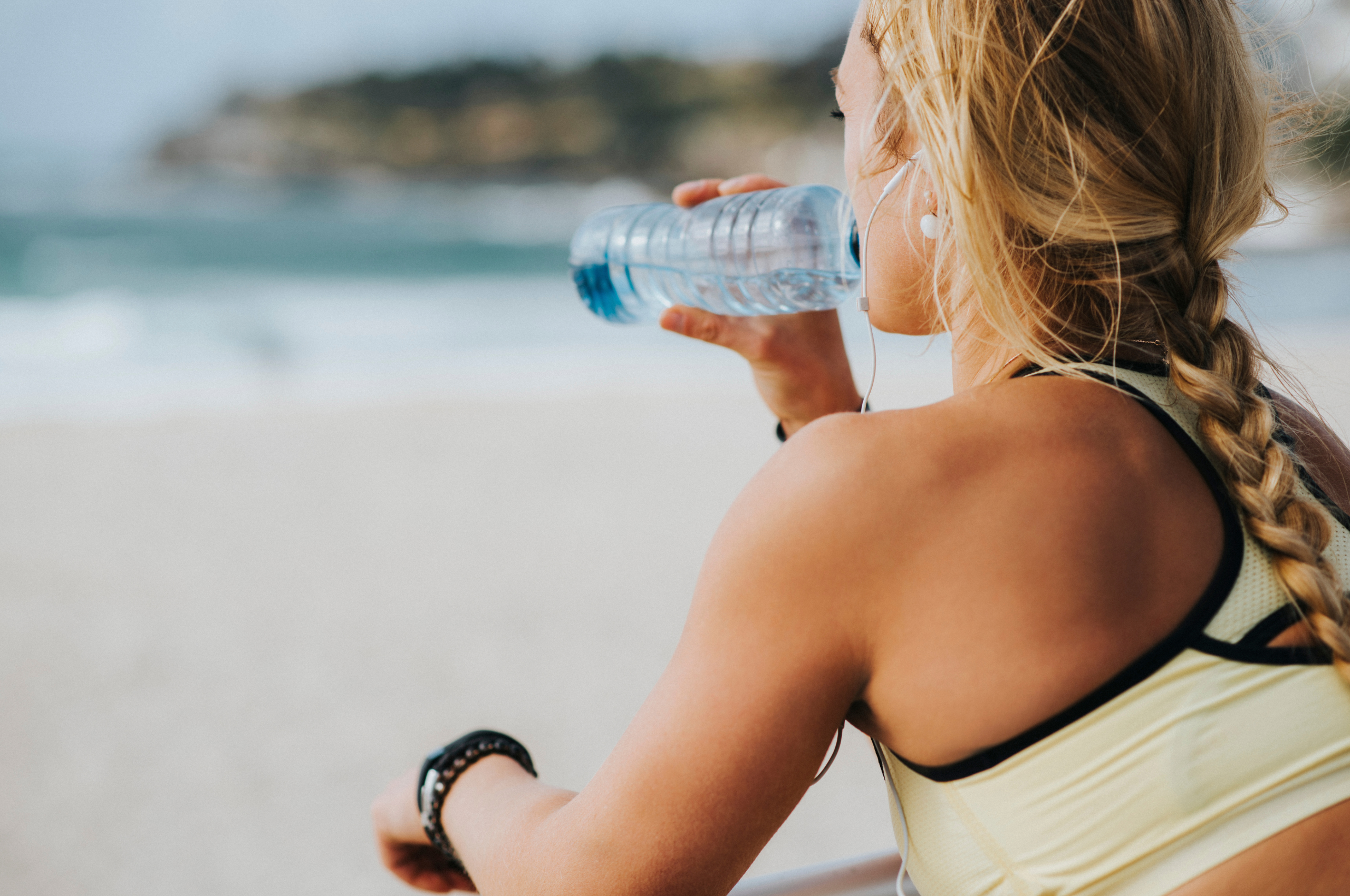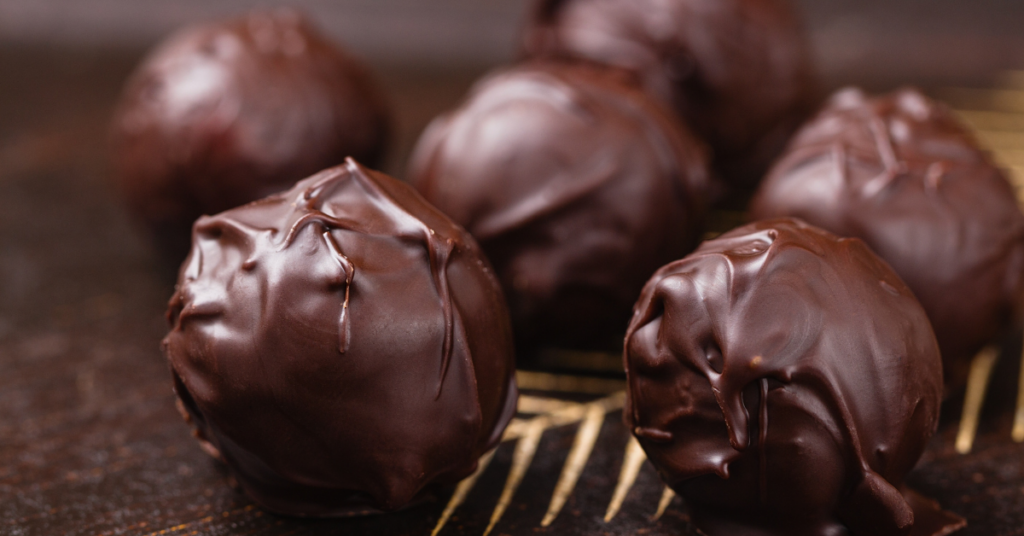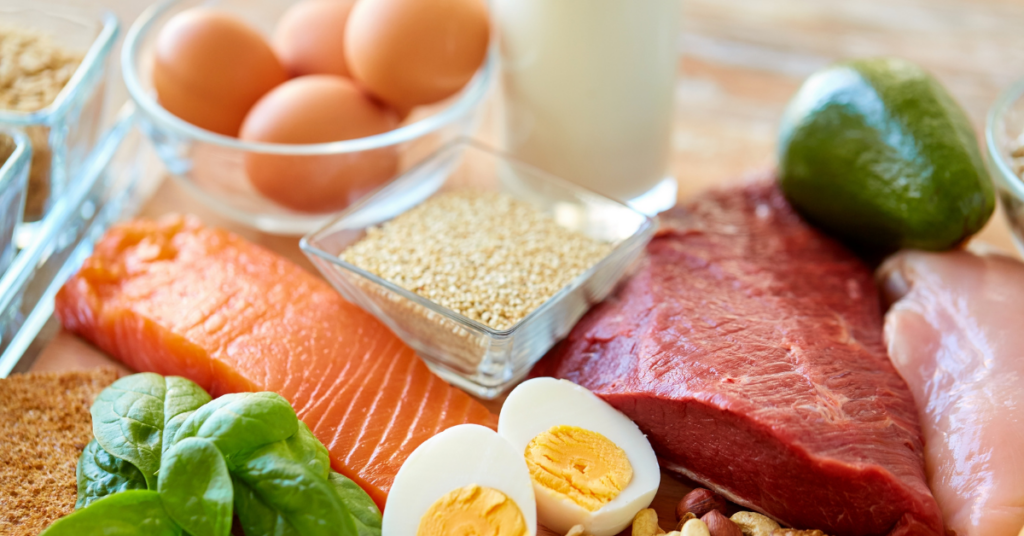Ultimate Guide to Summer Hydration and Electrolytes: Stay Refreshed and Energized!
In the summer, the heat and increased physical activity can lead to higher fluid losses through sweat, making hydration and electrolyte balance crucial for overall well-being. Proper hydration and electrolyte balance during the summer can help improve energy levels, prevent heat-related illnesses, support physical performance, and maintain overall health.
The Science Behind Hydration and Electrolytes
Our bodies require an adequate intake of fluids to support vital functions such as regulating body temperature, lubricating joints, transporting nutrients, and removing waste. Electrolytes, such as sodium and potassium, help maintain the balance of fluids inside and outside cells, ensuring optimal hydration and cell function.
Dehydration can lead to symptoms like fatigue, muscle cramps, impaired cognitive function, and reduced exercise performance. Electrolyte imbalances can disrupt cellular function, affecting muscle contractions, nerve impulses, and overall health.
Effective Hydration Strategies
Recommended daily water intake varies depending on factors such as age, activity level, and climate. As a general guideline, aiming for about eight, 8-oz servings or 2 liters, is often recommended, or dividing body weight in pounds by 2 to get the number of ounces per day as a starting place. It’s important to know that this fluid amount doesn’t need to be from water only. “Approximately 80% of daily water needs are provided by fluids ingested during the day, and the remaining 20% comes from water found in food.” (2)
Sources of Hydration
Hydration and fluids come from sources beyond plain water:
- Soups/broth
- Ice cream/ice pops/sorbets
- Infused water with fruits or herbs can add flavor and encourage hydration.
- Teas/coffee
- Food sources: fruits, vegetables, and milks
- Sports drinks provide electrolytes and/or carbohydrates
- Seltzer/soda water does count as liquids for hydration; however, it may have a slight diuretic effect by temporarily increasing urine production. This doesn’t impact overall hydration status significantly. Just be mindful of any additional ingredients and consume them in moderation as part of a well-balanced hydration strategy.
Understanding Electrolytes
Electrolytes are minerals such as sodium, potassium, calcium, and magnesium, and help maintain the optimal balance of water inside and outside cells. These are lost in urine or sweat. They have many essential functions in the body, including the following:
- Sodium plays a role in fluid balance, nerve function, and muscle contractions.
- Potassium is important for muscle and heart function.
- Calcium is involved in muscle contractions, bone health, and nerve signaling.
- Magnesium contributes to energy production, muscle relaxation, and protein synthesis.
Foods with electrolytes
Like food sources can provide some hydration through fluid, foods also contain electrolytes. Foods rich in electrolytes include bananas (potassium), spinach (magnesium), dairy products (calcium), and table salt (sodium). These types of foods can help maintain electrolyte balance.
Maintaining Electrolyte Balance
Electrolytes are vital for maintaining fluid balance and enhancing exercise performance. Adequate intake of electrolytes is essential for athletes and physically active individuals. Replenishing electrolytes during and after physical activity is important, especially for activities lasting longer than an hour or in hot environments.
Electrolyte imbalances can occur due to various factors such as excessive sweating, vomiting, diarrhea, certain medications, and medical conditions. Such imbalances can lead to symptoms like muscle cramps, weakness, irregular heartbeat, fatigue, confusion, and even life-threatening complications.
Signs and Symptoms of Dehydration
Signs of dehydration include increased thirst, dry mouth, dark urine, fatigue, dizziness, and reduced urine output.
A helpful Venn diagram is “WUT,” representing weight, urine, and thirst. These are the signs to consider when assessing personal hydration status. While one marker alone can’t give enough evidence for dehydration, knowing if you have two or more can be helpful. All three tell us dehydration may be very likely.
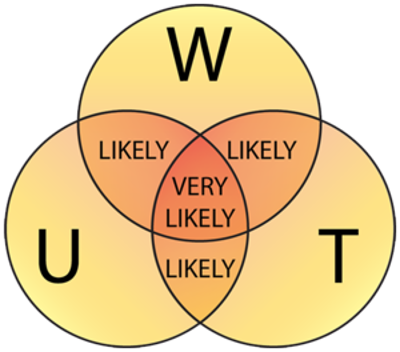
W – Weight:
“Day-to-day bodyweight losses in excess of 1% may be an indication of dehydration. This is a day-to-day loss of 1 lb (0.45 kg) for an athlete who weighs 100 lb (45.5 kg), 2 lbs (0.91kg) for an athlete weighing 200 lb (91 kg), or 3 lbs (1.4 kg) for an athlete weighing 300 lb (136.4 kg). To be more certain, combine body weight information with thirst or changes in urine (see Venn diagram.)
U – Urine:
It is normal to produce more urine when body water is high and less urine when body water is low. Therefore, urine volume is generally more related to body water or hydration level than to drinking patterns. So, if sweat losses are high, less urine may be produced despite normal or even increased fluid intake. Low urine production can cause it to be more concentrated and a darker color. A reduced daily urine frequency and darkening of urine color in a sample taken during the first urination of the morning may indicate dehydration. To be more certain, combine urine information with information on thirst or body weight (see Venn diagram.)
T – Thirst:
The absence of thirst does NOT indicate the absence of dehydration. However, the presence of thirst IS an indication of dehydration and the need to drink. Therefore, if thirst is present, combine that with urine or body weight information (see Venn Diagram) to be more certain.” (4, GSSI)
Electrolyte imbalances, such as low sodium levels, can worsen dehydration symptoms, leading to muscle cramps, confusion, and irregular heartbeat. Recognizing dehydration signs and addressing them promptly by rehydrating can prevent more severe complications and support optimal bodily function and performance.
Tips for staying hydrated during summer activities include drinking water before, during, and after exercise, monitoring urine color as a hydration indicator, and avoiding excessive alcohol intake, as it can have a temporary diuretic effect.

(Source: Mitchell K, Crigger C, Overholt T, et al. Dysfunctional Voiding: Does a validated urine color scale correlate with dysfunctional voiding severity score?. Marshall J Med. 2021; 7(4) DOI: https://doi.org/10.33470/2379-9536.1344.)
Hydration and Electrolytes for Specific Populations
Personal considerations are necessary for fluid and electrolyte needs including height, weight, age, medications and specific disease states. Physical activity, type/length, sweat rate, and exposure to heat can also increase these requirements.
While the Western diet can be higher in sodium, there may still be a need for electrolytes (including sodium). For athletes and physically active individuals, they will likely have a higher fluid and electrolyte need due to increased sweat losses.
Notice if you have salt on your lips, or see a white rim on clothes during or after a workout. This is salt, and it can help tell you if you’re a salty sweater or not.
The Recommended Dietary Allowances RDA for electrolytes for adults include:
- Sodium: 2,300 mg (*Individual needs and sodium losses should be considered)
- Potassium: 4,700 mg
- Magnesium: 310mg (adult females) 420 mg (adult males)
Supplemental electrolytes and beverages
Sports drinks and electrolyte supplements can be useful for certain individuals and are not necessary for everyone. Determine personal needs, an understanding of hydration status, and speak with a health care provider before implementing a new regimen.
Sports drinks can provide fluid, electrolytes, and carbohydrates (also considered energy). Consider if extra energy is needed through carbohydrates or if just electrolytes are needed when selecting a sports drink. Similarly, these considerations are also important when selecting a hydration supplement.
Salt is the largest electrolyte we lose in our sweat so it’s important for rehydration. If you’re not exercising regularly, or have a health reason to control intake, you may want a lower sodium option.
Reference this chart when selecting a sports drink or electrolyte supplement:
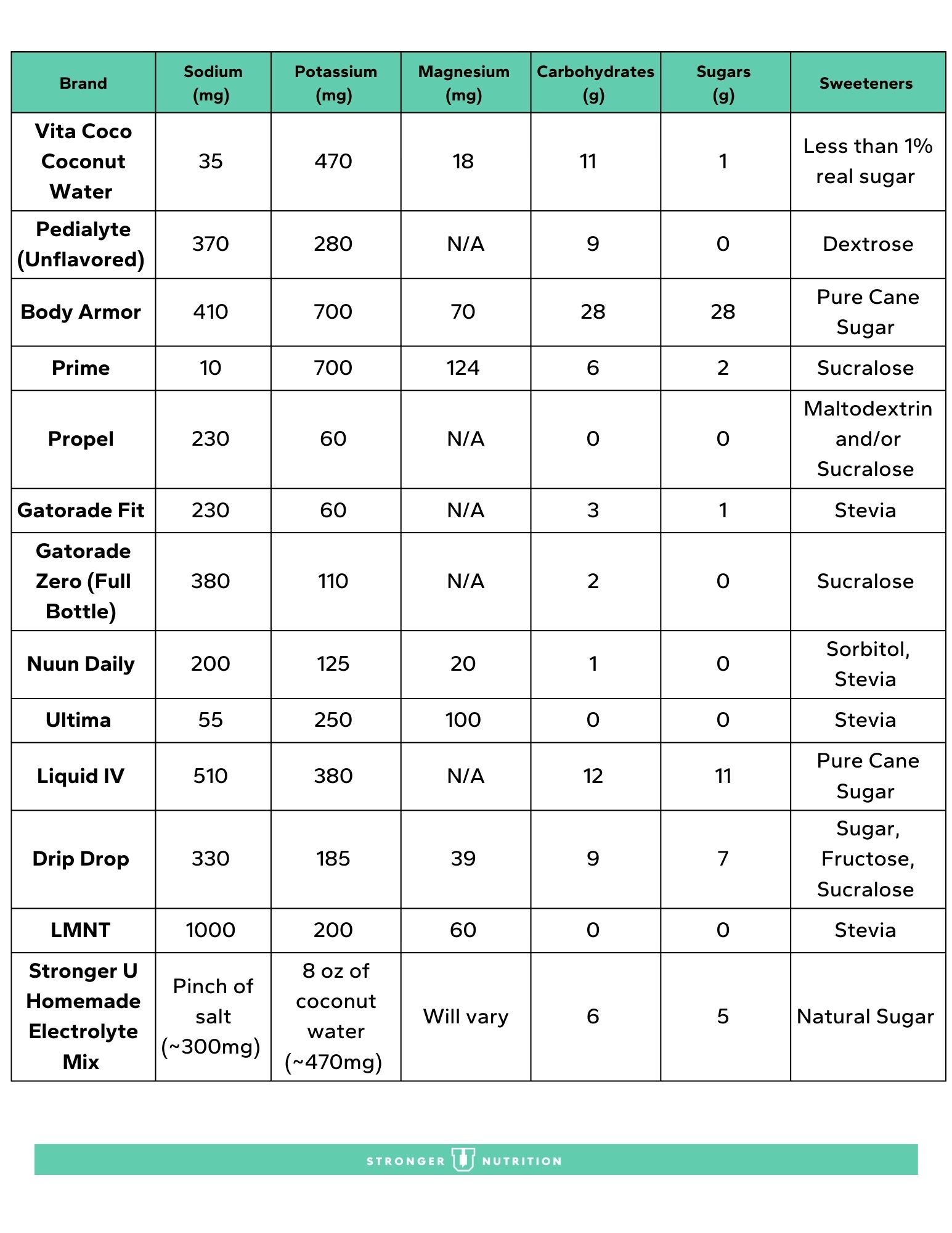
*For more information on gut health and sweeteners please see our blog on 10 Ways to Improve Your Gut Health Naturally.
*Please note: flavor and formulary will vary amounts shown above. For a most up to date listing, check out the brand website.
Stronger U Homemade Electrolyte Drink Recipe
Ingredients:
1 serving
- Pinch of salt (~300mg of sodium)
- 8 oz of coconut water (~470mg of potassium)
- Optional: magnesium supplement 1 serving
- Splash of lemon or lime juice
- Optional: 2-4 oz of orange or grapefruit juice (~6-13g of carbs)
Directions:
- Combine all ingredients and stir until well-mixed.
- Enjoy!
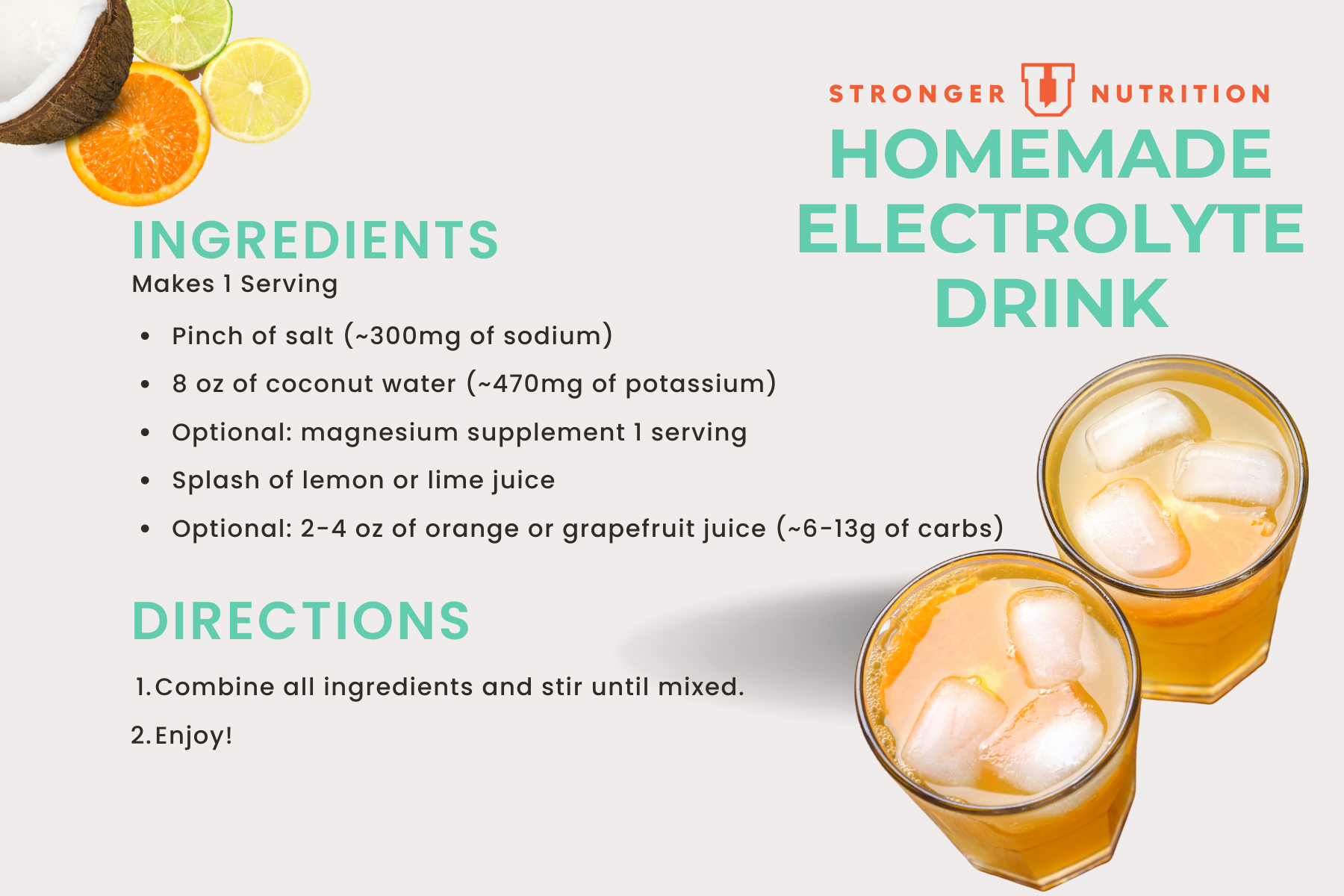
In conclusion, individual hydration needs can vary, and it’s essential to consider factors such as activity level, climate, and overall health when determining your specific fluid and electrolyte requirements. A Stronger U Coach can provide personalized hydration guidance to optimize intake, in addition to overall nutrition and lifestyle support. This is essential to prevent dehydration, maximize performance, and enhance recovery and well-being. Learn more about working with a Stronger U Coach and joining our inspiring community here.
Your Frequently Asked Questions, Answered:
How does an electrolyte supplement work?
An electrolyte supplement is a product that provides a concentrated dose of electrolytes in a convenient form, such as tablets, powders, or liquids. These supplements are designed to help replenish electrolytes in individuals who may have an imbalance or increased need for these minerals.
When you consume an electrolyte supplement, the minerals it contains, such as sodium, potassium, chloride, calcium, and magnesium, dissolve in the fluids of your digestive system. Once dissolved, these electrolytes are absorbed into the bloodstream and distributed throughout the body to the cells that require them. Thus, electrolytes help “hold on” to fluids and hydrate us.
The primary purpose of an electrolyte supplement is to restore electrolyte balance, particularly in situations where electrolyte losses are high. For example, during intense physical activity or prolonged periods of sweating, the body can lose significant amounts of electrolytes through sweat. In such cases, an electrolyte supplement can help replenish these minerals and restore the balance.
Electrolyte supplements can also be useful for individuals who experience certain health conditions that affect electrolyte levels, such as persistent vomiting, diarrhea, or other specific disorders.
It’s worth noting that while electrolyte supplements can be beneficial in certain circumstances, they should not be considered a replacement for a well-balanced diet. Whole foods, such as fruits, vegetables, whole grains, and lean protein sources, are excellent natural sources of electrolytes and provide additional essential nutrients that support overall health.
When choosing an electrolyte supplement, it’s essential to consider factors such as the specific electrolytes included, their concentrations, and any additional ingredients. It’s best to consult with your healthcare provider or RD before starting any new supplementation regimen, as they can provide personalized guidance based on your specific needs and circumstances.
Remember that maintaining electrolyte balance is crucial for overall health, but it’s important to avoid excessive intake of electrolytes as well. Consuming electrolytes within the recommended daily intake and in conjunction with a well-rounded diet is typically sufficient for most individuals to maintain proper electrolyte balance.
Do recreational sweaters need an electrolyte supplement?
Recreational sweaters, individuals who engage in moderate physical activity that causes sweating, generally do not require electrolyte supplements unless specific circumstances apply. In most cases, a well-balanced diet and proper hydration are sufficient to replenish electrolytes lost during recreational activities.
During moderate exercise or recreational activities, electrolyte losses through sweat are typically not significant enough to warrant supplementation for the average healthy individual. The body can usually maintain electrolyte balance through regular meals and fluid intake. However, if you engage in prolonged, intense exercise lasting more than an hour or participate in activities that result in excessive fluid and electrolyte losses, such as endurance events or prolonged outdoor activities in hot climates, electrolyte supplements may be beneficial and encouraged. These supplements can help ensure adequate replenishment of electrolytes and prevent imbalances that can lead to muscle cramps, fatigue, or other symptoms of electrolyte disturbances.
It’s important to note that individual needs may vary based on factors such as sweat rate, body composition, and individual tolerance. If you have concerns about your electrolyte balance during recreational activities, it’s always a good idea to consult with a healthcare professional or a registered dietitian who can assess your specific needs and provide personalized recommendations.
In summary, for most recreational sweaters, maintaining a well-balanced diet, staying adequately hydrated, and consuming electrolyte-containing beverages as needed during prolonged or intense exercise should be sufficient to maintain electrolyte balance. However, if you engage in activities with high sweat rates or prolonged duration, electrolyte supplements may be considered under the guidance of a healthcare professional or a registered dietitian.
REFERENCES:
Burke, L. (2019). Clinical Sports Nutrition.
Institue of Medicine. Dietary Reference Intakes for Water, Potassium, Sodium, Chloride, and Sulfate. Washington, DC: National Academies Press; 2004.
Sekiguchi Y, Benjamin CL, Butler CR, Morrissey MC, Filep EM, Stearns RL, Lee EC, Casa DJ. Relationships Between WUT (Body Weight, Urine Color, and Thirst Level) Criteria and Urine Indices of Hydration Status. Sports Health. 2022 Jul-Aug;14(4):566-574. doi: 10.1177/19417381211038494. Epub 2021 Aug 31. Erratum in: Sports Health. 2022 Apr 25;:19417381221084711. PMID: 34465235; PMCID: PMC9214901.
GSSI. (2005). Hydration Assessment of Athletes. Sports Science Exchange, 97, 18(2). Retrieved from https://www.gssiweb.org/sports-science-exchange/article/sse-97-hydration-assessment-of-athletes
Health.gov https://health.gov/sites/default/files/2019-09/Appendix-E3-1-Table-A4.pdf
